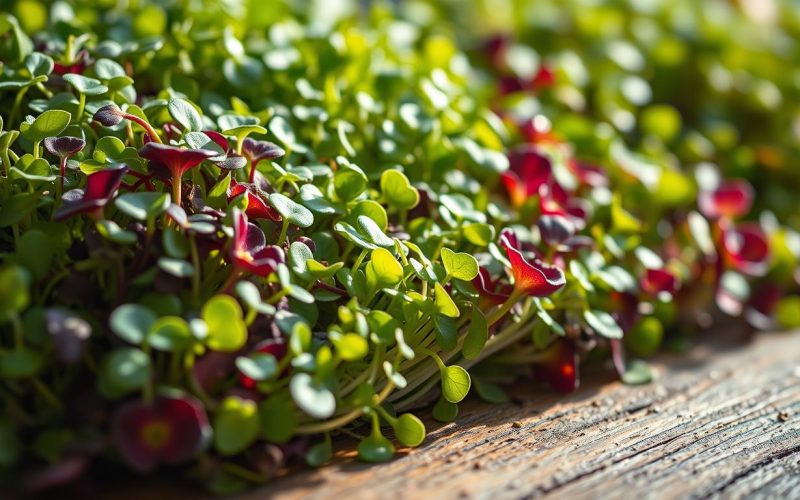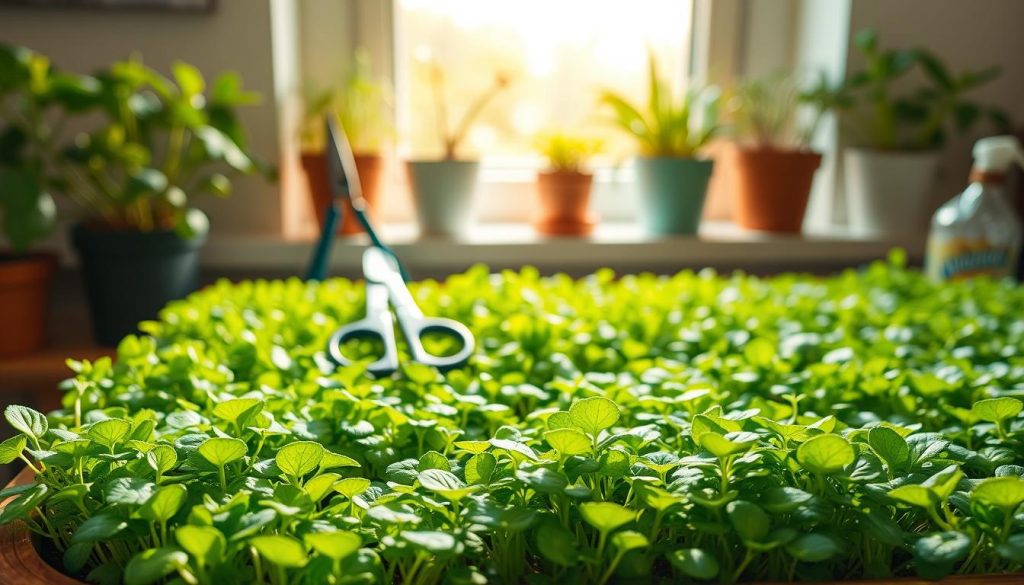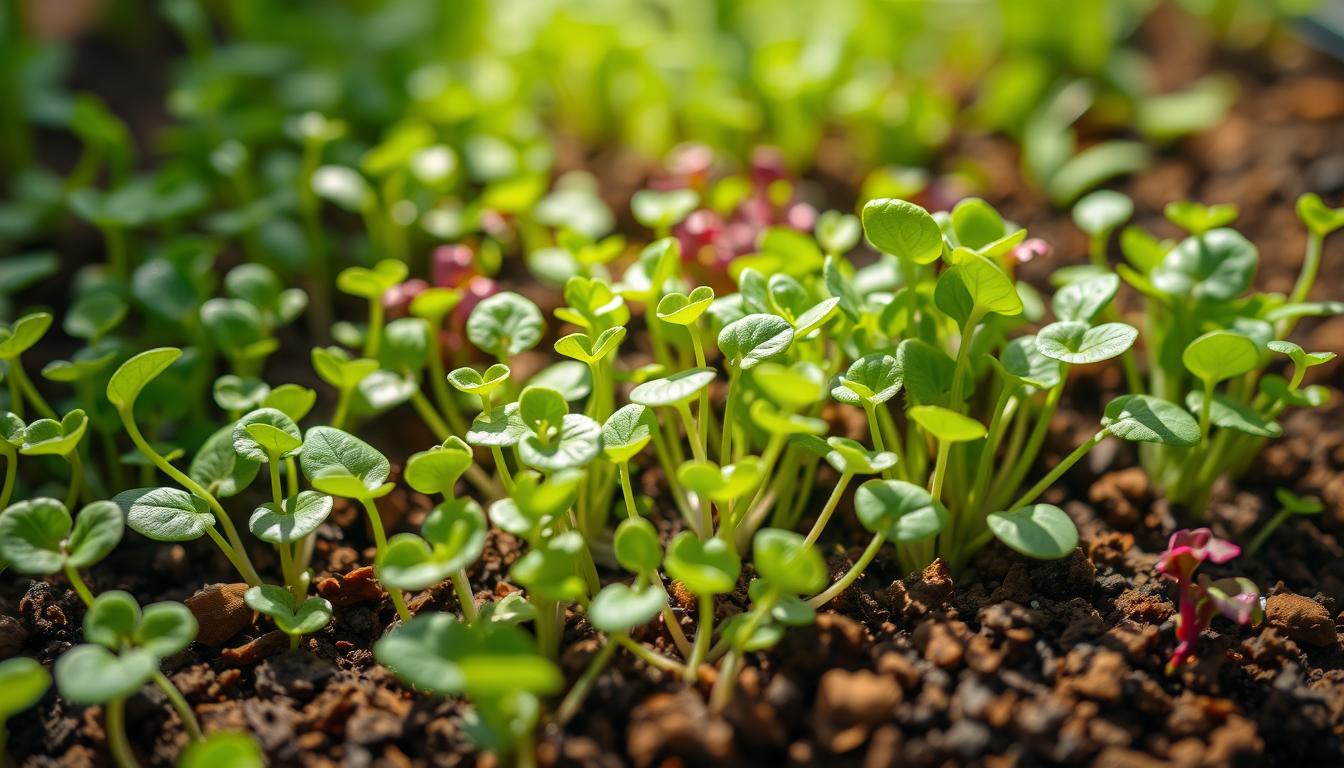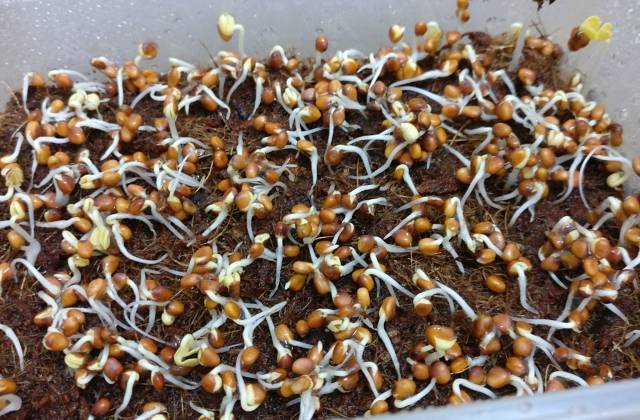Discover the Power of Microgreens: A Nutritious Addition

Microgreens have become a big deal in the world of food and health. They first showed up in California restaurants in the 1980s. Now, they’re changing how we eat and think about nutrition.
These small plants are packed with nutrients, much more than their size suggests. The market for microgreens is expected to hit $3.4 billion by 2030. They’re not just a trend; they’re a game-changer in the kitchen.
Microgreens are loved by chefs, nutritionists, and home cooks. They add a burst of flavor and are full of vitamins and minerals. This makes them a great choice for anyone looking to eat healthier.
Microgreens are making a big impact in both home kitchens and restaurants. They grow fast, need little space, and are super nutritious. They’re a fantastic way to add more health to your diet.
Key Takeaways
- Microgreens offer intense nutritional value in a compact form
- Market demand for microgreens continues to grow rapidly
- These tiny greens provide more nutrients than mature vegetables
- Versatile in culinary applications across different cuisines
- Easy to grow at home with minimal equipment
What Are Microgreens?
Microgreens are tiny, vibrant plants full of nutrition. They are loved by chefs, health fans, and gardeners. Unlike regular veggies, microgreens are picked when they’re just 1-3 inches tall.
Organic microgreens are different from sprouts and baby greens. They grow in soil, which makes them taste better and be more nutritious. These small greens are full of flavor and nutrients, making them great for food and health.
Defining Characteristics
- Height range: 1-3 inches tall
- Harvested 7-14 days after germination
- Vibrant colors ranging from deep green to purple
- Concentrated flavor profiles
- Rich in nutrients compared to mature vegetables
Popular Microgreens Varieties
There are many types of microgreens to choose from. Some favorites include:
- Radish microgreens (peppery flavor)
- Broccoli microgreens (mild, slightly bitter)
- Sunflower microgreens (nutty taste)
- Arugula microgreens (spicy kick)
- Basil microgreens (intense herbal notes)
Chefs and home cooks love microgreens for their taste and looks. They add flavor and nutrition to salads, sandwiches, and more. These tiny greens are a big hit for their taste and health benefits.
Nutritional Benefits of Microgreens
Nutrient-rich microgreens are tiny but mighty. They are full of vitamins, minerals, and antioxidants. These greens are more than just a garnish; they are a health boost for your daily meals.
Research shows microgreens are incredibly beneficial. They have much more nutrients than full-grown veggies. Some microgreens have up to 9 times more nutrients than their mature versions.
Vitamin and Mineral Content
Microgreens are packed with essential nutrients. They offer:
- Vitamin C for immune support
- Vitamin K for bone health
- Vitamin E for cellular protection
- Potassium for heart function
- Iron for oxygen transport
Antioxidant Powerhouse
Microgreens do more than just provide basic nutrients. They are also full of antioxidants. These help fight off cell damage. Studies show microgreens have up to 40 times more antioxidants than full-grown veggies, which can lower disease risks.
Adding microgreens to your meals is a smart choice. It boosts your nutrition and overall health.
How to Incorporate Microgreens into Your Diet
Microgreens are tiny but mighty in the kitchen. They add a burst of flavor and nutrients to any dish. You can buy them or grow them yourself, opening up a world of creative cooking.
- Sandwich and Wrap Enhancements: Sprinkle microgreens on sandwiches for a crisp texture and fresh flavor
- Smoothie Booster: Blend microgreens into morning smoothies for an instant nutritional upgrade
- Salad Transformer: Use as a primary or garnish ingredient in mixed salads
- Garnish for Hot Dishes: Top soups, pasta, and proteins with delicate microgreen layers
Perfect Pairings for Microgreens
Microgreens pair well with certain foods. Spicy radish microgreens are great with creamy dishes. Mild pea shoots are perfect with fish and chicken. Try different varieties to find your favorite flavors.
Innovative Culinary Techniques
Chefs and home cooks love using microgreens. Add them as a finishing touch, blend into pestos, or mix into egg dishes. The trick is to add them late to keep their nutrients and color.
Growing Microgreens at Home
Growing microgreens is an exciting journey that brings fresh greens to your kitchen. These tiny greens are easy to grow, great for urban gardeners and health fans. They add fresh flavors to your meals.

Essential Supplies for Microgreen Cultivation
- Shallow growing trays with drainage holes
- Organic potting soil or specialized microgreen growing medium
- High-quality microgreen seeds
- Spray bottle for gentle watering
- Grow lights or access to indirect sunlight
Step-by-Step Guide to Growing Microgreens
- Select your preferred microgreen seeds
- Fill tray with 1-2 inches of moistened growing medium
- Evenly spread seeds across the surface
- Lightly cover seeds with a thin layer of soil
- Mist with water and cover with a clear lid
- Place in a warm location with indirect light
- Maintain consistent moisture
- Harvest when first true leaves appear (7-14 days)
Learning to grow microgreens is easy and doesn’t cost much. With a bit of practice, you’ll grow fresh greens at home. The main things are to keep the soil moist, give them enough light, and harvest at the right time.
Choosing Quality Microgreens
Choosing the best microgreens is important. It matters whether you cook at home or focus on health. Knowing how to pick high-quality organic microgreens can change your cooking and health experience.
When looking for the best microgreens, several things matter. Fresh microgreens should look vibrant, crisp, and not wilted. Their look shows their nutritional value and taste.
Tips for Selecting Fresh Microgreens
- Look for bright, uniform color without brown or yellow spots
- Check for clean, intact stems and leaves
- Evaluate the overall freshness and moisture level
- Purchase from reputable local farmers or trusted organic suppliers
Understanding Labels and Certifications
Understanding organic microgreens can be tricky. It’s key to know about different labels:
- USDA Organic certification ensures no synthetic pesticides
- Non-GMO Project Verified indicates seed quality
- Local farm certifications might offer additional transparency
When buying seeds or pre-grown organic microgreens, choose reliable sources. They should share info on growing practices and risks. Good suppliers will give detailed info on how they grow their microgreens.
Microgreens vs. Mature Vegetables
Nutrient-rich microgreens are changing how we eat vegetables. These small plants are packed with nutrients, often more than full-grown veggies. They’re a great addition to any diet.
Looking at microgreens and full-grown veggies, we see big differences. Microgreens have much more vitamins and minerals than their bigger counterparts.
Nutrient Density Comparison
Studies show microgreens can have up to 40 times more nutrients than big veggies. They’re full of:
- More vitamins C, E, and K
- Higher antioxidants
- Denser minerals
- More phytonutrients
Flavor Profiles and Culinary Uses
Microgreens bring unique tastes and textures to cooking. Their strong flavors and soft textures are perfect for fancy dishes and adding a twist to meals.
- They add bright colors to food
- Bring intense flavor bursts
- Make dishes look interesting
- Act as healthy garnishes
Chefs and home cooks love microgreens. They’re not just healthy; they also make food special and exciting.
Popular Microgreens Varieties and Their Uses
Microgreens are tiny leaves packed with intense flavors and nutrients. They come in many varieties, each with its own unique taste. This makes them perfect for adding a gourmet touch to your dishes.
Trying out different microgreens can spark your creativity in the kitchen. Their flavors range from mild to bold, making them great for both home cooks and chefs.
Arugula and Radish Microgreens
Arugula microgreens add a peppery kick to your food. They’re perfect for:
- Topping salads with a zesty flavor
- Garnishing sandwiches and wraps
- Adding depth to pizza and pasta dishes
Radish microgreens have a sharp, spicy taste. They’re full of vitamins and add a crisp texture to your dishes.
Broccoli and Pea Shoots
Broccoli microgreens are super nutritious, with more nutrients than mature broccoli. They’re great in:
- Smoothies for an extra nutritional boost
- Egg dishes and omelets
- Stir-fries and grain bowls
Pea shoots have a sweet, delicate taste. They’re perfect for light salads, garnishes, or in fresh spring-inspired recipes.
Culinary Trends Featuring Microgreens
Microgreens have become a big deal in cooking, changing how chefs and home cooks make gourmet dishes. These small, packed-with-nutrients greens are making waves in restaurants and kitchens all over the U.S.
Top restaurants are now using microgreens as a key ingredient. They add great looks and taste. Chefs are finding new ways to use these greens in their famous dishes, making meals look and taste amazing.
Microgreens in Gourmet Cooking Techniques
- Garnishing high-end plates with vibrant microgreen varieties
- Creating texture layers in sophisticated dishes
- Enhancing flavor profiles with intense microgreen notes
For those wanting to cook with microgreens at home, you can find them at local farmers markets, specialty stores, and online. Many chefs suggest picking fresh, organic microgreens to make your dishes better.
Restaurant Spotlight on Microgreen Innovation
Michelin-starred restaurants are now offering special menus that highlight microgreens. They use them in creative ways, like on seafood carpaccio or in gourmet salads. These small greens are making a big impact in the kitchen.
- Chefs value microgreens for their concentrated nutrients
- Microgreens provide intense flavor in minimal quantities
- Visual presentation becomes extraordinary with microgreen garnishes
As cooking trends keep changing, microgreens stay at the top of the list. They promise to bring new and exciting ideas to both restaurant dishes and home cooking.
Commercial Production of Microgreens
The microgreens industry is growing fast. Market forecasts show big growth in the next few years. Organic microgreens are becoming a big part of the farm market, drawing in both small farmers and big producers.
Starting a microgreens farm is both exciting and challenging. The market could hit $3.4 billion by 2030. North America is leading the way in making these greens.
Industry Overview
- The organic microgreens market is growing fast.
- More restaurants and health-focused people want them.
- There’s a chance for farms in cities and up high.
Key Challenges in Large-Scale Production
- Keeping quality the same in big batches.
- Controlling costs and staying competitive.
- Storing and moving these fragile greens safely.
- Following strict food safety rules.
To succeed in growing microgreens on a big scale, you need a good plan. You also need to know how to grow them well and understand the market. It’s all about finding the right balance between being efficient and taking care of these special plants.
The outlook for microgreens is bright. New tech and more people knowing about them will keep the industry growing.
The Environmental Impact of Microgreens
Microgreens are becoming a green choice for food lovers. These small, nutrient-packed plants are good for the planet. They’re perfect for home gardens and big farms looking to grow microgreens.

Organic microgreens are more than just a new food trend. They need less water and land than regular crops. This makes them great for growing in cities and indoors.
- They use less water than regular crops.
- They need less land to grow.
- They’re perfect for growing in cities and indoors.
- They grow fast and can be harvested many times.
Sustainability Benefits
Growing microgreens is a new way to make local food. These plants can grow in small spaces like windowsills or indoor gardens. This cuts down on emissions and carbon footprint from big farms.
Reducing Food Waste
Microgreens help reduce food waste. They grow fast and are full of nutrients. This means almost all of the plant can be eaten, cutting down on waste.
By choosing microgreens, people help make food production more sustainable. They get to enjoy fresh, healthy food with less harm to the environment.
Future of Microgreens in Nutrition and Wellness
The world of microgreens is growing fast, moving beyond just food. Scientists are finding new ways these tiny greens can help us stay healthy. They’re becoming key in our diets, helping us feel better overall.
Studies show microgreens are packed with good stuff for our bodies. Experts are studying them to learn more about their health benefits. They think microgreens could help prevent diseases and fill nutritional gaps with just a little bit.
Research and Emerging Trends
Now, the beauty and health industries are taking notice of microgreens. Companies are working on ways to use their nutrients in new products. You’ll see microgreen extracts in face creams and health supplements soon.
Potential Developments in Consumption
People want more microgreens, and technology is making them available all year. You can find them in cities and health stores everywhere. Soon, we’ll have even more ways to add these greens to our daily lives.



